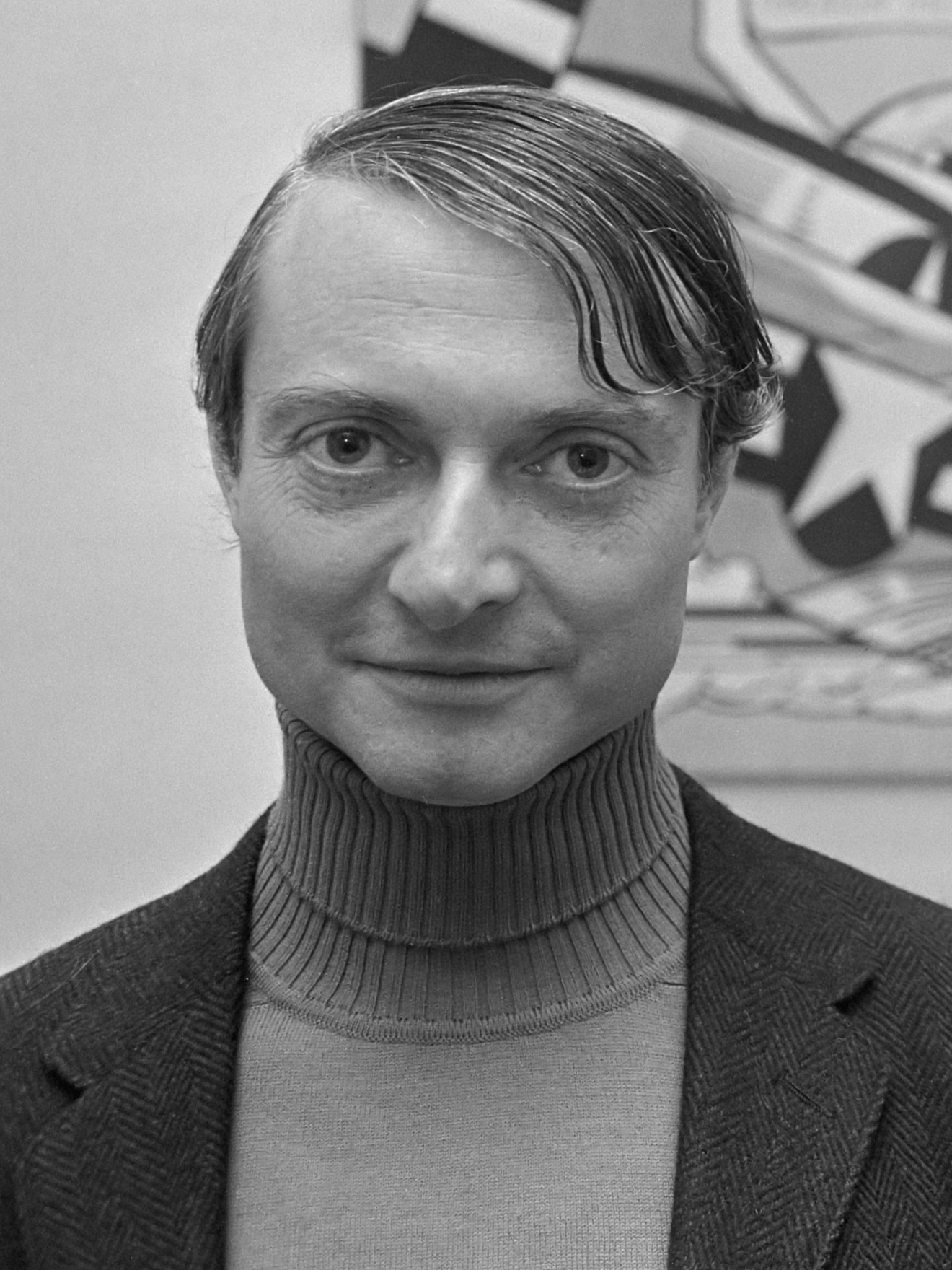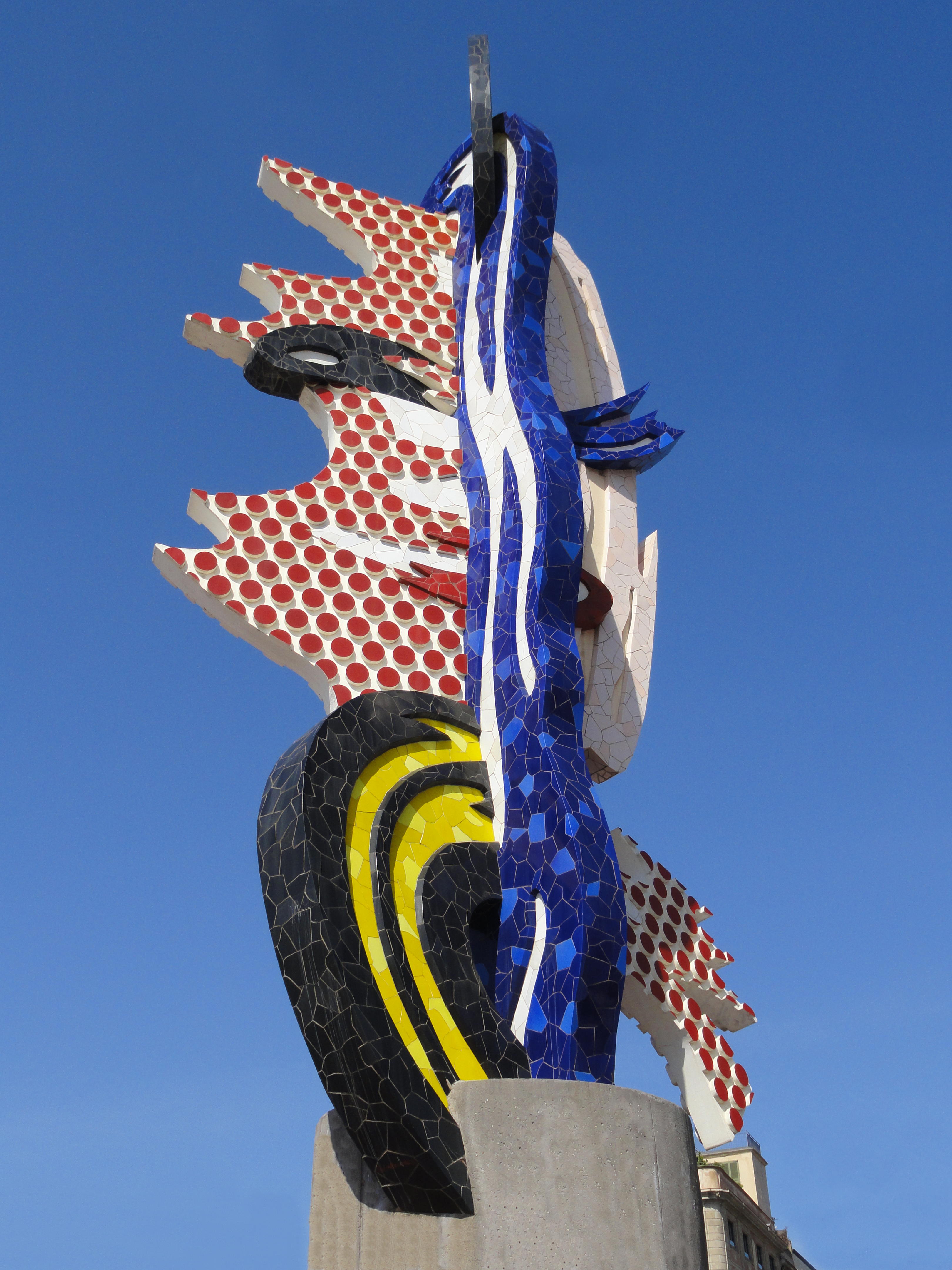|
Whaam!
''Whaam!'' is a 1963 diptych painting by the American artist Roy Lichtenstein. It is one of the best-known works of pop art, and among Lichtenstein's most important paintings. ''Whaam!'' was first exhibited at the Leo Castelli Gallery in New York City in 1963, and purchased by the Tate Gallery, London, in 1966. It has been on permanent display at Tate Modern since 2006. The left-hand panel shows a fighter plane firing a rocket that, in the right-hand panel, hits a second plane which explodes in flames. Lichtenstein adapted the image from several comic-book panels. He transformed his primary source, a panel from a 1962 war comic book, by presenting it as a diptych while altering the relationship of the graphical and narrative elements. ''Whaam!'' is regarded for the temporal, spatial and psychological integration of its two panels. The painting's title is integral to the action and impact of the painting, and displayed in large onomatopoeia in the right panel. Lichtenstein s ... [...More Info...] [...Related Items...] OR: [Wikipedia] [Google] [Baidu] |
Roy Lichtenstein
Roy Fox Lichtenstein (; October 27, 1923 – September 29, 1997) was an American pop artist. During the 1960s, along with Andy Warhol, Jasper Johns, and James Rosenquist among others, he became a leading figure in the new art movement. His work defined the premise of pop art through parody. Inspired by the comic strip, Lichtenstein produced precise compositions that documented while they parodied, often in a tongue-in-cheek manner. His work was influenced by popular advertising and the comic book style. His artwork was considered to be "disruptive". He described pop art as "not 'American' painting but actually industrial painting". His paintings were exhibited at the Leo Castelli Gallery in New York City. ''Whaam!'' and '' Drowning Girl'' are generally regarded as Lichtenstein's most famous works. ''Drowning Girl'', ''Whaam!,'' and ''Look Mickey'' are regarded as his most influential works. His most expensive piece is '' Masterpiece'', which was sold for $165 million ... [...More Info...] [...Related Items...] OR: [Wikipedia] [Google] [Baidu] |
As I Opened Fire
''As I Opened Fire'' (sometimes ''As I Opened Fire...'') is a 1964 oil and magna on canvas painting by Roy Lichtenstein. The work is hosted at the Stedelijk Museum in Amsterdam. The source of the subject matter is Jerry Grandenetti's panels from "Wingmate of Doom," in ''All American Men of War'', no. 90 (March–April 1962), DC Comics. Detail Measuring 170 cm × 430 cm (68 in × 168 in), ''As I Opened Fire'' is a triptych with verbal and temporal continuity. In 1972, it was regarded as "...perhaps Lichtenstein's most ambitious exercise in strangely uniting, visually (as well as figuratively) warring elements." Depicting a short few seconds during an aircraft battle, the painting is based on three panels of the original narrative which Lichtenstein has altered to improve its formal coherence. This piece represents his affinity toward the high school "...highly emotional content, yet detached impersonal handling..." ''As I Opened Fire'' exhibits Lichtenstein's "formal i ... [...More Info...] [...Related Items...] OR: [Wikipedia] [Google] [Baidu] |
Onomatopoeia
Onomatopoeia is the process of creating a word that phonetically imitates, resembles, or suggests the sound that it describes. Such a word itself is also called an onomatopoeia. Common onomatopoeias include animal noises such as ''oink'', ''meow'' (or ''miaow''), ''roar'', and ''chirp''. Onomatopoeia can differ between languages: it conforms to some extent to the broader linguistic system; hence the sound of a clock may be expressed as ''tick tock'' in English, in Spanish and Italian (shown in the picture), in Mandarin, in Japanese, or in Hindi. The English term comes from the Ancient Greek compound ''onomatopoeia'', 'name-making', composed of ''onomato''- 'name' and -''poeia'' 'making'. Thus, words that imitate sounds can be said to be onomatopoeic or onomatopoetic. Uses In the case of a frog croaking, the spelling may vary because different frog species around the world make different sounds: Ancient Greek (only in Aristophanes' comic play ''The Frogs'') probably ... [...More Info...] [...Related Items...] OR: [Wikipedia] [Google] [Baidu] |
Neo-Dada
Neo-Dada was a movement with audio, visual and literary manifestations that had similarities in method or intent with earlier Dada artwork. It sought to close the gap between art and daily life, and was a combination of playfulness, iconoclasm, and appropriation. In the United States the term was popularized by Barbara Rose in the 1960s and refers primarily, although not exclusively, to work created in that and the preceding decade. There was also an international dimension to the movement, particularly in Japan and in Europe, serving as the foundation of Fluxus, Pop Art and Nouveau réalisme. Neo-Dada has been exemplified by its use of modern materials, popular imagery, and absurdist contrast. It was a reaction to the personal emotionalism of Abstract Expressionism and, taking a lead from the practice of Marcel Duchamp and Kurt Schwitters, denied traditional concepts of aesthetics. Trends Interest in Dada followed in the wake of documentary publications, such as Robert Moth ... [...More Info...] [...Related Items...] OR: [Wikipedia] [Google] [Baidu] |
Hard-edge Painting
Hard-edge painting is painting in which abrupt transitions are found between color areas. Color areas are often of one unvarying color. The Hard-edge painting style is related to Geometric abstraction, Op Art, Post-painterly Abstraction, and Color Field painting. History of the term The term was coined by writer, curator and ''Los Angeles Times'' art critic Jules Langsner, along with Peter Selz, in 1959, to describe the work of painters from California, who, in their reaction to the more painterly or gestural forms of Abstract expressionism, adopted a knowingly impersonal paint application and delineated areas of color with particular sharpness and clarity. This approach to abstract painting became widespread in the 1960s, though California was its creative center. Other, earlier, movements, or styles have also contained the quality of hard-edgedness, for instance the Precisionists also displayed this quality to a great degree in their work. Hard-edge can be seen to be assoc ... [...More Info...] [...Related Items...] OR: [Wikipedia] [Google] [Baidu] |
Minimalism (visual Arts)
Minimalism describes movements in various forms of art and design, especially visual art and music, where the work is set out to expose the essence, essentials or identity of a subject through eliminating all non-essential forms, features or concepts. As a specific movement in the arts it is identified with developments in post–World War II Western Art, most strongly with American visual arts in the 1960s and early 1970s. Prominent artists associated with this movement include Ad Reinhardt, Nassos Daphnis, Tony Smith, Donald Judd, John McCracken, Agnes Martin, Dan Flavin, Robert Morris, Larry Bell, Anne Truitt, Yves Klein and Frank Stella. Artists themselves have sometimes reacted against the label due to the negative implication of the work being simplistic. Minimalism is often interpreted as a reaction to abstract expressionism and a bridge to postminimal art practices. History Minimalism in visual art, generally referred to as "minimal art", ''literalist art'', and ' ... [...More Info...] [...Related Items...] OR: [Wikipedia] [Google] [Baidu] |
Art Movement
An art movement is a tendency or style in art with a specific common philosophy or goal, followed by a group of artists during a specific period of time, (usually a few months, years or decades) or, at least, with the heyday of the movement defined within a number of years. Art movements were especially important in modern art, when each consecutive movement was considered as a new avant-garde movement. Western art had been, from the Renaissance up to the middle of the 19th century, underpinned by the logic of perspective and an attempt to reproduce an illusion of visible reality ( figurative art). By the end of the 19th century many artists felt a need to create a new style which would encompass the fundamental changes taking place in technology, science and philosophy ( abstract art). Concept According to theories associated with modernism and the concept of postmodernism, ''art movements'' are especially important during the period of time corresponding to modern art. The per ... [...More Info...] [...Related Items...] OR: [Wikipedia] [Google] [Baidu] |
Bugs Bunny
Bugs Bunny is an animated cartoon character created in the late 1930s by Leon Schlesinger Productions (later Warner Bros. Cartoons) and voiced originally by Mel Blanc. Bugs is best known for his starring roles in the '' Looney Tunes'' and '' Merrie Melodies'' series of animated short films, produced by Warner Bros. Though an early iteration of the character first appeared in the WB cartoon ''Porky's Hare Hunt'' (1938) and a few subsequent shorts, the definitive characterization of Bugs Bunny is widely credited to have debuted in Tex Avery's Oscar-nominated film ''A Wild Hare'' (1940). Bob Givens is credited for Bugs' initial character design, though Robert McKimson is credited for what became Bugs' definitive design just a few years later. Bugs is an anthropomorphic gray and white rabbit or hare who is famous for his flippant, insouciant personality. He is also characterized by a Brooklyn accent, his portrayal as a trickster, and his catch phrase "Eh...What's up, doc?". Due ... [...More Info...] [...Related Items...] OR: [Wikipedia] [Google] [Baidu] |
Mickey Mouse
Mickey Mouse is an animated cartoon Character (arts), character co-created in 1928 by Walt Disney and Ub Iwerks. The longtime mascot of The Walt Disney Company, Mickey is an Anthropomorphism, anthropomorphic mouse who typically wears red shorts, large yellow shoes, and white gloves. Taking inspiration from such Silent film, silent film personalities as Charlie Chaplin’s The Tramp, Tramp, Mickey is traditionally characterized as a sympathetic underdog who gets by on pluck and ingenuity. The character’s status as a small mouse was personified through his diminutive stature and falsetto voice, the latter of which was originally provided by Disney. Mickey is one of the world's most recognizable and universally acclaimed fictional characters of all time. Created as a replacement for a prior Disney character, Oswald the Lucky Rabbit, Mickey first appeared in the short ''Plane Crazy'', debuting publicly in the short film ''Steamboat Willie'' (1928), one of the first Sound film, ... [...More Info...] [...Related Items...] OR: [Wikipedia] [Google] [Baidu] |
Oxford Art Online
Oxford Art Online is an Oxford University Press online gateway into art research, which was launched in 2008. It provides access to several online art reference works, including Grove Art Online (originally published in 1996 in a print version, ''The Dictionary of Art''), the online version of the ''Benezit Dictionary of Artists'', and ''The Oxford Companion to Western Art''. It also provides access to other Oxford art reference works, including the ''Encyclopedia of Aesthetics ''Encyclopedia of Aesthetics'', published in 1998 by Oxford University Press, is an encyclopedia that covers philosophical, historical, sociological, and biographical aspects of Art and Aesthetics worldwide. The second edition (2014) is now availab ...'' (2nd edition), and ''The Concise Oxford Dictionary of Art Terms''. The site was updated on 1 December 2017 to enhance page design, search tools, linking, and media capabilities. [...More Info...] [...Related Items...] OR: [Wikipedia] [Google] [Baidu] |
Abstract Expressionism
Abstract expressionism is a post–World War II art movement in American painting, developed in New York City in the 1940s. It was the first specifically American movement to achieve international influence and put New York at the center of the Western art world, a role formerly filled by Art in Paris, Paris. Although the term "abstract expressionism" was first applied to American art in 1946 by the art critic Robert Coates (critic), Robert Coates, it had been first used in Germany in 1919 in the magazine ''Der Sturm'', regarding German Expressionism. In the United States, Alfred Barr was the first to use this term in 1929 in relation to works by Wassily Kandinsky. Style Technically, an important predecessor is surrealism, with its emphasis on spontaneous, Surrealist automatism, automatic, or subconscious creation. Jackson Pollock's dripping paint onto a canvas laid on the floor is a technique that has its roots in the work of André Masson, Max Ernst, and David Alfaro Siqu ... [...More Info...] [...Related Items...] OR: [Wikipedia] [Google] [Baidu] |




